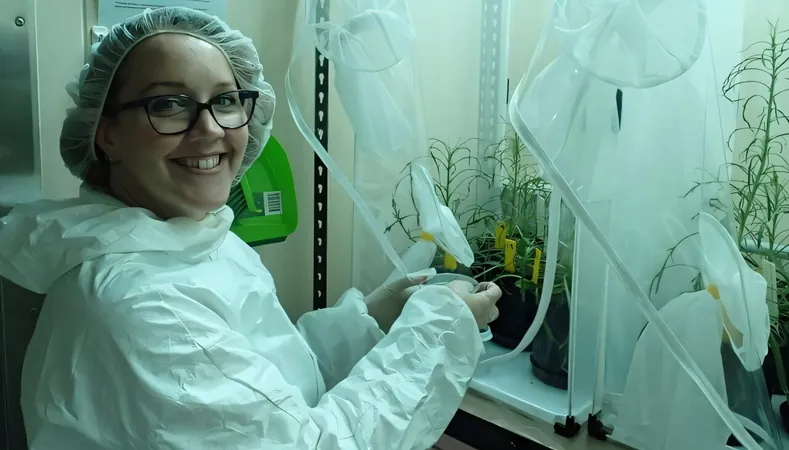
Unearthing Nature's Allies: How Host Specificity Testing Revolutionizes Weed Control
2024-11-12
Author: Sarah
Imagine a world where weeds don’t run rampant and choke the life out of our native flora. Thanks to biocontrol methods that leverage natural adversaries, this dream is becoming a reality. Biocontrol employs certain organisms—like insects and fungi—that prey on invasive weeds, offering a safe, economical, and large-scale solution to manage these stubborn plants. But there's a catch: we must ensure these biocontrol agents won't harm our native species.
The Initial Investigation
The journey begins where the invasive weed originates. For example, researchers might travel to South America to study the Cabomba weevil or to France for the sea spurge fungus. The goal? Identify insects that feast on the target weed and analyze their feeding behaviors on closely related plants in their native habitat. Michelle Rafter, an entomologist immersed in plant-insect interactions, emphasizes the importance of understanding each insect’s dietary preferences.
“Even generalist insects can often be secret specialists, favoring a primary host while occasionally dabbling with secondary options,” she notes. Chemical signals emitted by plants play a key role in how these insects identify their food sources.
Life Cycle Impact
Understanding which stage of the weed's life cycle to target is paramount. An insect that merely munches on leaves might not do enough damage if the weed can shed its leaves in drought conditions. Conversely, an insect that feeds on seeds can halt reproduction and offer a more effective control strategy.
The initial screening phase employs rigorous tests to observe the insects' reactions to various test plants. If any of Australia’s native plants share close genetic ties to the target weed, we tread cautiously. Overlapping chemical signals could mislead these biocontrol agents.
Testing: The Quarantine Phase
Once potential insects are imported, they undergo a comprehensive risk assessment in quarantine. The “no-choice” test—one of the most pivotal evaluations—restricts insects to test plants where they must decide their fate solely based on their instincts. Observing their feeding habits and reproductive behaviors provides essential data on their host specificity.
Should the insects be seen thriving on various plants, it's an indication they might not be selective enough to avoid damaging native species. Conversely, if they withhold feeding, it's a promising sign of specificity.
In the “choice testing” phase, insects are confronted with options—both their target weeds and other plants they’ve previously dined upon. By observing their preferences, researchers can predict how these insects might behave in real-world scenarios.
Long-Term Viability
To ensure that a proposed agent can thrive sustainably, researchers observe multiple generations. If the population crashes after a few cycles, it's a clear indicator that the target plant cannot support them long-term.
But if there’s uncertainty about a biocontrol agent, there’s an added layer of testing: sending specimens abroad for open field evaluations. This method checks if the insects can recognize and utilize non-preferred plants as hosts when placed in uncontrolled environments.
Learning from Mistakes: The Cane Toad Dilemma
The notorious case of the cane toad serves as a crucial reminder of the need for scientific rigor in biocontrol initiatives. Lacking any formal testing, the cane toad was released with the unproven assumption it would manage cane beetle populations. Instead, it failed miserably due to its ecological mismatch, illustrating the disastrous results of cutting corners in biological control efforts.
The Bright Future of Biocontrol
Despite past blunders, the future of weed biocontrol looks promising. Michelle Rafter emphasizes that while it’s not a miracle cure, integrating biocontrol into a holistic weed management strategy is essential.
“Biocontrol remains an indispensable tool in our toolbox,” she concludes, underscoring the ongoing need for rigorous host testing in ensuring the safety and effectiveness of biocontrol agents. By adhering to stringent biosecurity regulations, we set the stage for a sustainable partnership with nature—harmonizing ecosystems rather than disrupting them.
Stay tuned, as this remarkable science unfolds and reveals exciting prospects for ecological balance!


 Brasil (PT)
Brasil (PT)
 Canada (EN)
Canada (EN)
 Chile (ES)
Chile (ES)
 España (ES)
España (ES)
 France (FR)
France (FR)
 Hong Kong (EN)
Hong Kong (EN)
 Italia (IT)
Italia (IT)
 日本 (JA)
日本 (JA)
 Magyarország (HU)
Magyarország (HU)
 Norge (NO)
Norge (NO)
 Polska (PL)
Polska (PL)
 Schweiz (DE)
Schweiz (DE)
 Singapore (EN)
Singapore (EN)
 Sverige (SV)
Sverige (SV)
 Suomi (FI)
Suomi (FI)
 Türkiye (TR)
Türkiye (TR)